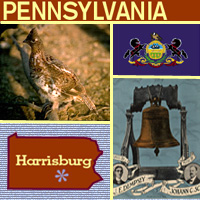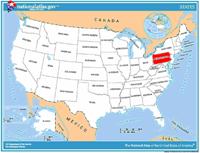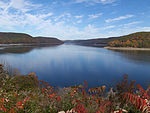|
Additional Lessons |
 About These
Lessons About These
Lessons
The following classroom lessons are great for students
who want additional listening and reading practice. |
-
Travel America -
Beginner
Level. Do you love America and American
English? Learn before you travel. Facts and other
cool stuff about your favorite U.S. state. Great
English reading practice.
|
 Travel
America - Pennsylvania Travel
America - Pennsylvania
(Beginner -
Reading)
Learn some interesting facts and read interesting
stories about Pennsylvania. |
 Pennsylvania Pennsylvania
Although Swedes and Dutch were the first European
settlers, William Penn, a Quaker, named Pennsylvania
in honor of his father by combining the name Penn
and the Latin term sylvania, which translates as
"woodlands," to come up with "Penn's woodlands."
Known as the "Keystone State," Pennsylvania is one
of the original 13 colonies (it entered the Union in
1787). Today, two major cities dominate the
state--Philadelphia, home of the Liberty Bell,
Constitution Hall, and a thriving metropolitan area,
and Pittsburgh, a busy inland river port. The Amish,
a group of people who live without the use of modern
technology, live in the countryside of Pennsylvania.
The capital is Harrisburg and the state bird is the
ruffed grouse. |
 Pennsylvania
State Flag Pennsylvania
State Flag
The first state flag of Pennsylvania was authorized
by the General Assembly in 1799. A law was passed in 1907
standardizing the flag and requiring that the blue field
match the blue of "Old Glory" (the national flag).
Pennsylvania's flag features the state coat of arms on a
field of blue. The state motto appears on a ribbon at the
base of the design ("Liberty, Virtue, Independence"). The
Pennsylvania coat of arms is also featured on the state
seal. |
|
Source:
State Symbols USA |
|
|
 Pennsylvania
State Facts Pennsylvania
State Facts
Picture: state seal of Pennsylvania |
|
State Capital |
Harrisburg |
|
Nickname |
Keystone State |
|
Motto |
Virtue, Liberty, and Independence |
|
Statehood |
December 12, 1787 |
|
Origin of Name |
Named in honor of Admiral William Penn, father of
William Penn the state's founder, and means Penn's
Woods |
|
Largest Cities |
Philadelphia, Pittsburgh, Erie, Allentown, Scranton |
|
Border States |
Delaware, Maryland, New Jersey, New York, Ohio, West
Virginia |
|
Area |
44,820 sq. mi., 32rd |
|
State Bird |
Ruffed Grouse |
|
State Flower |
Mountain Laurel |
|
State Tree |
Eastern Hemlock |
|
State Song |
Pennsylvania |
 Travel and
tourism site for Pennsylvania - This state travel and
territorial tourism site provides ideas for your vacations,
meetings, and more. Travel and
tourism site for Pennsylvania - This state travel and
territorial tourism site provides ideas for your vacations,
meetings, and more. |
|
|
Pennsylvania Stories |
|
|
The Civil War in Pennsylvania
What was the most important battle in Pennsylvania during the Civil
War?
It was the Battle of Gettysburg, which took place on July 1 through
3, 1863, in southern Pennsylvania. The battle was General Robert E.
Lee's final attempt to invade the North. Even though the Union army
won the battle, more than 51,000 soldiers were killed, wounded, or
captured in the bloodiest battle of the entire war.
At the dedication ceremony of the National Cemetery at Gettysburg on
November 19, 1863, President Abraham Lincoln delivered his famous
speech, the Gettysburg Address. You may have heard the famous
opening words before: "Four score and seven years ago." The
Gettysburg Address is a very short speech. It is less than 300
words, and it probably seemed even shorter at the time because
Lincoln delivered his address after a two-hour speech by orator
Edward Everett.
At one point in the Gettysburg Address, Lincoln says: "We here
highly resolve that these dead shall not have died in vain, that
this nation, under God, shall have a new birth of freedom and that
government of the people, by the people, for the people, shall not
perish from the earth." Lincoln is unclear when he talks about the
soldiers who died during the Battle of Gettysburg. Perhaps he wanted
Southerners to believe he was including the Confederate as well as
the Union soldiers. By calling for a "new birth of freedom" for the
nation, Lincoln may have been asking the South to rejoin the union. |
|
|
Rivers of Steel
What American city do you think of when you think of steel?
If you answered Pittsburgh, you are right. As a major source of
steel products and technology, Pittsburgh and southwestern
Pennsylvania were once a powerful hub of the Industrial Age -- one
that pushed the United States to world leadership as an industrial
giant.
Pittsburgh steel was used to build some of the most important
structures of the modern age: the Brooklyn Bridge, the Panama Canal
locks, the Empire State Building, Rockefeller Center, the Oakland
Bay Bridge, and the United Nations. During World War II,
southwestern Pennsylvania became known as America's "Arsenal of
Democracy," because its mills were working around the clock to make
enough steel for America and its allies. Andrew Carnegie (see the
"Amazing Americans" section of this Web site) became the richest man
in the world because of his ownership of steel mills.
Today, Pittsburgh no longer dominates world steel production, but
the nonprofit Rivers of Steel Corporation seeks to preserve the
heritage of the area. |
|
|
National Freedom Day
What holiday is celebrated on February 1?
It's National Freedom Day. The purpose of this holiday is to promote
good feelings, harmony, and equal opportunity among all citizens and
to remember that the United States is a nation dedicated to the
ideal of freedom.
Major Richard Robert Wright Sr., a former slave, fought to have a
day when freedom for all Americans is celebrated. When Wright got
his freedom, he went on to become a successful businessman and
community leader in Philadelphia, Pennsylvania. Major Wright chose
February 1 as National Freedom Day because it was the day in 1865
that President Lincoln signed the 13th Amendment to the
Constitution. Do you know what the 13th Amendment did?
This amendment, an important change to our written law, outlawed
slavery in the United States. Wright gathered national and local
leaders together to write a bill declaring February 1 "National
Freedom Day" and President Harry Truman signed the bill in 1948
making it official. |
|
|
Pittston Tomato Festival
Is a tomato a fruit or a vegetable?
More than 40,000 people come to the Pittston Tomato Festival to
celebrate one of Pittston's favorite fruits. That's right, fruits!
Although the tomato is not sweet, it is a fruit rather than a
vegetable. That's because science calls a fruit any fleshy material
covering the seeds of a plant. The tomato has seeds inside, so it is
a fruit -- so are cucumbers, green peppers, and squash. We often
refer to them as vegetables, though, because of the way they taste.
We tend to think of fruits as sweet; it's a handy way to distinguish
between the different kinds of plants that we eat.
The people of Pittston, Pennsylvania, love the tomato, whether it is
a fruit or a vegetable. What's your favorite fruit? |
|
|
Hazleton Funfest
Does your town have an annual festival, just for fun? Hazleton,
Pennsylvania, does.
Every year since 1979 the town has had a "Super Weekend" filled with
parades, contests and food. Originally held only for one day and
called "Funfest," the event was expanded into a weekend celebration
in 1986. One of the festival's activities is a pizza-eating contest;
contestants have to stuff themselves with cold pizza (a local
specialty)! For people who don't want to eat pizza, there are other
contests, like the Funfest Bed Rally and the first Fireman's
Competition. Individuals may also enter their barbecued chicken
wings in the "Wings Cook-Off." Or perhaps some young man is brave
enough to enter Hazleton's Hunk Contest: the winner is declared the
cutest guy in Hazleton! |
|
|
Ligonier Highland Games
Have you ever heard of a "heavy athlete"? No, it's not an overweight
ballplayer; it's someone who takes part in traditional Scottish
games. The Highland Games in Ligonier, Pennsylvania, offer plenty of
heavy athletes the opportunity to compete in events like
tree-throwing. How would you like to throw a tree?
By the time of the Revolutionary War, it was estimated that one out
of every three people living in western Pennsylvania was of Scottish
ancestry. Today, the people of Ligonier celebrate their Scottish
heritage by holding the Ligonier Highland Games. The most popular
games are called "heavy athletics." These games are a test of
strength and skill for those who compete. Ancient Scottish leaders,
chieftains, originally used Highland games to select the best men to
go into battle. But in Ligonier the games are just for fun!
Heavy athletes do things like throw big stones or even hammers to
see who can throw the farthest. They also compete in a game called
the caber toss. Caber is Gaelic (the traditional language of
Scotland) for tree. The caber used in the Ligonier Highland Games is
a tree trunk more than 14 feet long! |
|
|
Central Market in Lancaster, Pennsylvania
You've probably been to a supermarket more times than you can
remember. But have you ever been to a market where the people who
produce the food are the ones who sell it?
Lancaster's Central Market is one of the oldest continuously
operating public farmer's markets in the nation. For 270 years, the
people of Lancaster have come to the central market square area to
buy foods from local growers and producers. People began meeting
here to sell and shop in the 1730s. The current building used for
the market, called the Central Markethouse, was built in 1889.
Nowadays we are used to visiting the local supermarket to buy fruit
from California or meat from Chicago. In Colonial times, people had
to eat whatever was available to them locally. In the winter, they
ate root vegetables such as turnips and onions, rather than tomatoes
or green peppers, which were only available in the summer. Today,
people still like to seek out locally grown food for its freshness
and taste. |
|
Source:
Library of Congress |
|
 National
Forests of
Pennsylvania National
Forests of
Pennsylvania
The following is a description of national
forests in the state
of Pennsylvania. There are no national parks
or monuments in this state. If you plan to visit or
live in Pennsylvania for awhile then you
should definitely plan to visit some of
these fantastic places. |
|
|
|
National Forests |
 Allegheny Allegheny
Pennsylvania's only National Forest includes
Kinzua Dam and Allegheny Reservoir on the
Allegheny Plateau in the northwestern part
of the state. The forest contains the
largest tract of remaining old-growth forest
in Pennsylvania at Tionesta Scenic and
Research Natural Areas and 10 mi (16 km) of
the North Country Trail. |
|
|
|
 Travel
America Travel
America
Do you love America and American English? Learn before
you travel. Facts and other cool stuff about your
favorite U.S. state. Visit the Fun Easy English Travel
America pages. Read about the beautiful National
Forests, Parks, and Monuments. Great English reading practice. |
 Drive America Drive America
Planning to drive in America? Learn the rules and
regulations. Great English reading practice. |
|